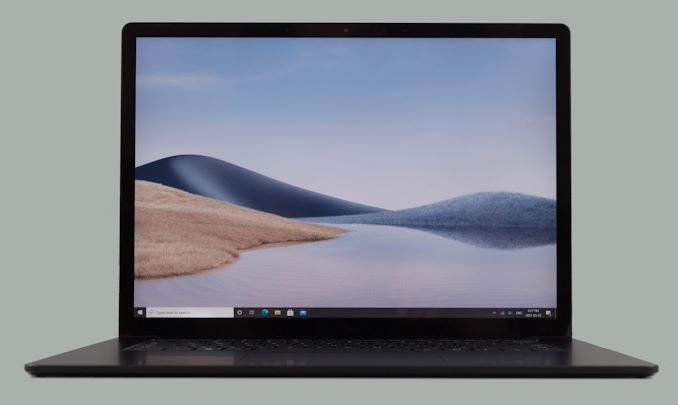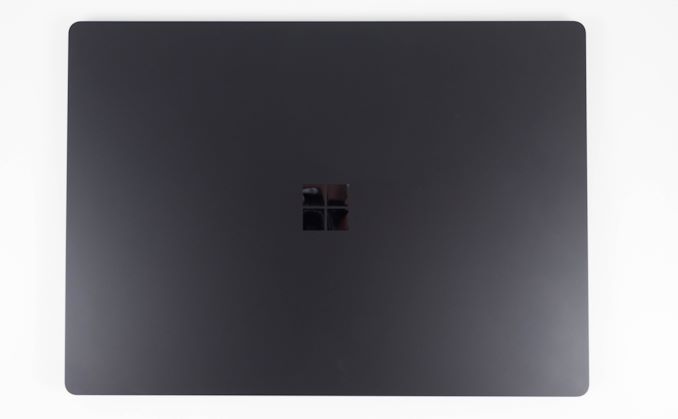The Microsoft Surface Laptop 4 15-Inch Review: Refreshing Ryzen
by Brett Howse on May 6, 2021 8:00 AM ESTFinal Words
In late 2019, when Microsoft launched the Surface Laptop 3 – their first AMD-powered Surface laptop – it was an important moment for both AMD and Microsoft's Surface group. AMD finally had a premium design win, and what better manufacturer did they have to work with than Microsoft themselves. Tweaks to improve performance and battery life could be easily replicated across all Windows PCs, which was a big help for AMD at the time. At the end of the day Microsoft's help still wasn't enough to make the AMD Ryzen 3000-based Surface Laptop 3 a bona fide winner – it performed worse than the Intel Ice Lake model and suffered from poor battery life – but it put AMD and Microsoft on the path towards building bigger and better laptops later on.
And now with the Surface Laptop 4 and the Ryzen 4000 APUs, Microsoft and AMD have resolved many (if not most) of the issues that dogged their earlier laptop. In fact, the Surface Laptop 4 is easily the best Ryzen 4000 laptop on the market. Microsoft has worked with AMD to deliver unique processors for the Surface Laptop 4 which are the strongest Renoir-U chips you can get. The increased frequency, coupled with eight cores and sixteen threads, makes for a very capable notebook computer.
And, unlike the Picasso-powered Surface Laptop 3, the AMD choice not only closes the gap in terms of battery life, according to Microsoft, the AMD model even surpasses the Tiger Lake model. Although we have not tested the Tiger Lake Surface Laptop 4 (yet?), the results from this Ryzen 7 model are excellent. Even with the 15-inch, 201 pixels-per-inch display, the Surface Laptop 4 was able to go toe-to-toe with some of the best designs on the market which have smaller displays. That is impressive.
Speaking of impressive, Microsoft’s attention to detail on the display really sets all Surface devices apart from the rest of the manufacturers. With any Surface device you purchase, from the least expensive, to the most expensive, the display accuracy is some of the best in the industry. The 3:2 aspect ratio is always a treat to use in any productivity task. The 201 pixels-per-inch makes the display sharp, and while a bit more contrast ratio would be appreciated, overall, this is an excellent implementation. It even includes a pen digitizer and touch support.
System performance with the Ryzen 7 4980U was excellent. Offering up sixteen threads, the Surface Laptop 4 gobbled up any multi-threaded task thrown at it. The Vega 8 graphics, while not class-leading, are still very strong for an integrated solution. Perhaps one area where the AMD model is let down though is that Microsoft only lets you configure it up to 16 GB of memory, whereas the Tiger Lake powered model has up to 32 GB as a maximum. This is an odd decision and will hopefully be addressed during the device’s lifetime.
Less impressive were the storage results on this review unit, which were some of the lowest we've seen for an NVMe drive in an OEM laptop. But the good news is that Microsoft has committed to utilizing M.2 storage on Surface again, after a brief stint of employed soldered in BGA storage. Customers will be able to replace the drive if it fails, or upgrade it. After years of making some of the most challenging to repair devices, Microsoft has turned a corner somewhat on repairability, with a new design that is easier to get into, and actually has some replaceable components.
With two sizes, a choice of colors, and even keyboard materials, there is a lot to like here. Microsoft offers a single USB Type-A, as well as a single USB Type-C, and additional expansion options through the Surface Connect port. This is not a workstation by any means, but it is nice to have both ports and not need to use dongles for Type-A devices.
Otherwise, although there was a bit of disappointment to see the Surface Laptop announced with the Ryzen 4000 series processors in 2021 instead of AMD's latest 5000 series processors, I believe those feelings can be set aside. There is little doubt that a Ryzen 5000 version of this laptop would be even more powerful with its Zen 3 cores, but Microsoft’s semi-custom Ryzen 7 4980U still performs very well, and should put any of those thoughts to bed. The Surface Laptop design is also mostly unchanged for the last several generations, and it could use a refresh, but that being said, the design was never really a hindrance before, and it is still pleasing to use today.
It is amazing what a generational improvement can do. The Surface Laptop 4 achieves great performance, and great battery life, and does so all in a pleasing package, with a great display, fantastic keyboard, smooth trackpad, and a thin and light design. On the outside, it would be hard to tell it apart from the Surface Laptop 3, but it’s what’s on the inside that counts. This refreshed model is just what the Surface Laptop needed.













98 Comments
View All Comments
LarsBars - Thursday, May 6, 2021 - link
Any word on why the AMD version is not offered with 32GB? Kind of hampering the 8c/16t with that ram configuration...WaltC - Thursday, May 6, 2021 - link
So apparently the uptake here is: if you buy your Surface to play games, get the Intel-nVidia combo; but if you buy your surface for computational performance you buy the AMD versions...SNESChalmers - Thursday, May 6, 2021 - link
What Intel/Nvidia combo? SL4 is Tigerlake/Xe or Renoir/VegaAlistair - Thursday, May 6, 2021 - link
he was referring to the massively overprice Surface book, not "4"Smell This - Thursday, May 6, 2021 - link
Only if you are, apparently, using the Xe with *96 Execution Units*
Nothing about the i5-1145G7 and *80 Execution Units,* and the i7-1065G7 with 64 EUs kinda gets thumped ...
iphonebestgamephone - Thursday, May 6, 2021 - link
Ok?Smell This - Friday, May 7, 2021 - link
I've got a stalker ... LOL
iphonebestgamephone - Friday, May 14, 2021 - link
Then do something about it. Read my comment to your other comment.brucethemoose - Thursday, May 6, 2021 - link
A tiny criticism: the hardware encoding test is apples to oranges, as all 3 encoders have different speed presets. Even at the same bitrate, the AMD encoder may be spitting out worse looking video at its default settings, or it may be better.Not that I mind the test. In fact, thats a huge buying factor for me. But (unless you want to dive into VMAF measurements), maybe add a little disclaimer?
eastcoast_pete - Thursday, May 6, 2021 - link
Agree, and made a similar comment regarding the hardware-assisted video encoding. For this, NVIDIA's NVENC (since Turing) is still the best; AFAIK, neither Intel not AMD have updated their encoding ASIC and/or are still behind on quality. One reason why I am reluctant to get an AMD dGPU (assuming they are even in stock).